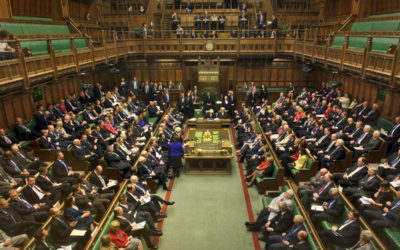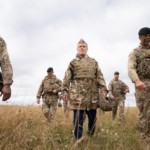War trauma hits young soldiers hardest: new report
ForcesWatch press release
Post-war mental health problems are most common in young soldiers from disadvantaged backgrounds.
Read the ForcesWatch response to the Ministry of Defence’s statement about this report
Young soldiers recruited from disadvantaged backgrounds are substantially more likely than other troops to return from war experiencing problems with their mental health, says a wide-ranging report published today by human rights group ForcesWatch.
The report, The Last Ambush: Aspects of mental health in the British armed forces, draws on over 150 sources, including 41 British military mental health studies, as well as testimony from veterans. It shows that, compared with older personnel, younger recruits are significantly more likely to suffer post-traumatic stress disorder (PTSD), to drink at levels harmful to health, and to behave violently on their return from war. Young recruits from disadvantaged backgrounds are at greatest risk.
Citing studies of large, representative samples of the armed forces, the report finds that:
- 8% of Iraq War veterans who enlisted without GCSEs or Scottish Standards met the criteria for post-traumatic stress disorder (PTSD) after their deployment, compared with 4% in the armed forces as a whole and 3% in the general population.(i) Personnel without GCSEs typically enlist at younger ages.
- 26% of personnel aged 18-24 were found to be drinking at levels harmful to health, which is twice the 13% average for the armed forces and more than three times the 8% rate found among civilians of similar age.(ii)
- 24% of Iraq War veterans in the lowest ranks, who are typically the youngest, reported behaving violently in the weeks following their homecoming; the average rate across the armed forces was 13% .(iii) The rate of violent offending among Iraq and Afghanistan War veterans after their deployment was twice what is was before they enlisted.(iv)
- Over the past 20 years, the suicide rate has been 82% higher among male soldiers under 20 than among civilian men of the same age.(v) The suicide rate among former armed forces personnel aged under 20 has been nearly three times as high as that in the same age group in the general population (between 1996 and 2005).(vi)
Given that there remains a stigma in the armed forces attached to reporting mental health issues and most studies do not assess personnel fully anonymously, the true prevalence of mental health problems is likely to be higher than these figures suggest.(vii)
As a group, younger personnel from adverse childhood backgrounds are both more vulnerable to war stress and over-represented in front-line Infantry roles where exposure to traumatic experiences is greatest, the report explains. Recruits who enlist at age 16 or 17 are channelled in disproportionate numbers into the Infantry, becoming deployable to war as soon as they turn 18. Although it accounts for just 14% of the armed forces, in the last five years the Infantry received 32% of all new recruits aged under 18 (compared with 24% of adult recruits).(viii) The Infantry has suffered a fatality rate in Afghanistan some seven times that seen in the rest of the armed forces, says the report,(ix) and those who enlisted into the Army at 16 have been at greatest risk.(x) In contrast, personnel who enlist as adults and hold stronger qualifications join a wider range of roles; they are therefore, in general, less exposed to traumatic stress in warfare.
The report calls for the policy of recruiting from age 16 to be reviewed so that the greatest burden of risk is not left to the youngest, most vulnerable recruits to shoulder. Raising the minimum age of recruitment to 18 would ensure that recruits share the risks more equally and that they assume them at the age of adult responsibility . The report notes that the UK is the only state in the European Union to recruit from age 16 and one of only 19 worldwide; most state armed forces now recruit only adults.(xi)
David Gee, the report’s author, said: ‘When it comes to the trauma of warfare, recruits from the poorest backgrounds face a “perfect storm” of pre-existing vulnerability and greater battlefield exposure. Recruiting 16 year olds into the Infantry puts the most vulnerable group in roles most exposed to trauma when they turn 18 and are sent to war.’
The report discusses why some veterans are more psychologically affected than others. It shows that a combination of recruits’ pre-enlistment situation, military factors such as rank and exposure to combat, and the support available to veterans when leaving the forces, all affect mental health in the long-term. Although younger recruits from disadvantaged backgrounds are more likely than others to experience mental health problems regardless of their war experience, traumatisation in warfare is the main explanatory factor for their greater psychological burden, as a number of British and US studies have shown.(xii)
[ENDS]
See details of the report here
Read the ForcesWatch response to the Ministry of Defence’s statement about this report
For more information, contact ForcesWatch: press@forceswatch.net
Notes to Editors
‘The Last Ambush? Aspects of mental health in the British armed forces’ is a ForcesWatch report written by armed forces researcher David Gee. The 80-page document is the result of nine months’ research. It draws on over 150 sources, including 41 studies investigating the prevalence of, and risk factors for, six mental health-related problems in the British armed forces. The report also includes testimony from veterans. The six outcomes investigated are: post-traumatic stress disorder (PTSD), common mental disorders (types of anxiety and depression), harmful drinking, post-deployment violence, self-harm, and suicide.
David Gee is a researcher based in London. He has studied armed forces personnel issues since 2007 and authored or co-authored a number of influential research reports.
ForcesWatch scrutinises armed forces recruitment practices and proposes changes in policy aimed at better serving the interests of young people. http://www.forceswatch.net
One of the striking findings of the report is the much higher prevalence of mental health problems among veterans who have left the armed forces in the last decade. Compared with Iraq or Afghanistan war veterans still in service, PTSD is nearly three times as common among those who have left. These former personnel are also more likely to have a number of other mental health-related problems.(xiii)
Statistical References
i PTSD rates by GCSE attainment from Iversen AC, Fear NT, Ehlers A, Hacker Hughes J, Hull LM, Greenberg N, et al. ‘Risk factors for post-traumatic stress disorder among UK Armed Forces personnel’. Psychological Medicine. 2008; 38: p. 511-522 (Refer to Table 1). Figure for armed forces as a whole from Jones M, Sundin J, Goodwin L, Hull L, Fear NT, Wessely S, et al. ‘What explains posttraumatic stress disorder (PTSD) in UK service personnel: deployment or something else?’. Psychological Medicine (ePub 2012 Nov 13). 2012; 43(8): p. 1703-12 (Refer to p. 1705). Civilian figure from McManus S, et al. (2009) op. cit. (Refer to p. 57) [Note that this general population figure has been adjusted to the gender profile of the armed forces to provide a more appropriate comparison].
ii 64% of this sample aged 18-24 had deployed to Iraq or Afghanistan or both. In the armed forces as a whole, alcohol misuse is more common among deployed troops. See Fear NT, Jones M, Murphy D, Hull L, Iversen AC, Coker B, et al. ‘What are the consequences of deployment to Iraq and Afghanistan on the mental health of the UK armed forces? A cohort study’. The Lancet. 2010 May; 375: p. 1783-1797 (Refer to Table 2 and Supplementary Webappendix, col. 3). Civilian figure is for ages 16-24, from McManus S, Meltzer H, Brugha T, Bebbington P, Jenkins R. ‘Adult psychiatric morbidity in England, 2007: Results of a household survey’. University of Leicester, The NHS Information Centre; 2009. (Refer to Table 9.1) [Note that this general population figure has been adjusted to the gender profile of the armed forces to provide a more appropriate comparison].
iii MacManus D, Dean K, Al Bakir M, Iversen AC, Hull L, Fahy T, et al. ‘Violent behaviour in UK military personnel returning home after deployment’. Psychological Medicine. 2012; 42: p. 1663-1673. The figure relating to rank is calculated from Table 1. In addition, post-deployment violent behaviour is much more common among personnel who experienced multiple traumatic events in the war zone (refer to ‘The Last Ambush’, p. 38, for detail).
iv MacManus D, Dean K, Jones M, Rona R, Greenberg N, Hull L, et al. ‘Violent offending by UK military personnel deployed to Iraq and Afghanistan: a data linkage cohort study’. The Lancet. 2013; 381: p. 907-917. Refer to Discussion, p. 913, and Figure 2.
v Defence Analytical Services and Advice. ‘Suicide and Open Verdict Deaths in the UK Regular Armed Forces: Edition 1984-2012’. [Online].; 2013. Cited 2013 June 16. Available from: http://www.dasa.mod.uk/applications/newWeb/www/index.php?page=48&pubType=1&thiscontent=250&PublishTime=09:30:00&da te=2013-03-28&disText=1984%20-%202012&from=listing&topDate=2013-03-28. [Despite years given in title, the period investigated was 1993 to 2012 inclusive.]
vi Age-specific rate ratio: 292.9:100. Kapur N, While D, Blatchley N, Bray I, Harrison K. ‘Suicide after Leaving the UK Armed Forces ? A Cohort Study’. Public Library of Medicine. 2009 March; 6(3) Refer to Table 1.
vii For example, see Langston V, Gould M, Greenberg N. ‘Culture: What Is Its Effect on Stress in the Military?’. Military Medicine. 2007; 172(9): p. 931-935 and Fear NT, Seddon R, Jones N, Greenberg N, Wessely S. ‘Does anonymity increase the reporting of mental health symptoms?’. BMC Public Health. 2012; 12(797). See also ‘The Last Ambush’, p. 13-14
viii Calculated from DASA Annual Personnel reports and Hansard: HC Deb, 13 May 2013, c99W; refer to ‘The Last Ambush’, p. 57-58 for full details of calculation and sources used.
ix Fatality rate calculated from official fatalities listing. Ministry of Defence. ‘British Fatalities: Operations in Afghanistan’. [Online].; 2013. Cited 2013 April 1. Available from: https://www.gov.uk/government/fields-of-operation/afghanistan. For detail, refer to ‘The Last Ambush’, Table 11.
x In a study published in August this year, ForcesWatch and Child Soldiers International showed that Army recruits who enlisted at 16 and completed their training have been approximately twice as likely to die in Afghanistan as those who enlisted as adults. Gee D, Goodman A. ‘Young age at Army enlistment is associated with greater war zone risks’. [Online]. London; 2013. Cited 2013 September 3. Available from: https://www.forceswatch.net/wp-content/uploads/Young_age_at_army_enlistment_greater_risks%28FINAL%29.pdf.
xi For details, see Child Soldiers International and ForcesWatch. ‘One Step Forward: The case for ending recruitment of minors by the British armed forces’. London:; 2013.
xii For example, see Iversen et al. (2008) op. cit.; Rona RJ, Hooper R, Jones M, Iversen AC, Hull L, Murphy D, et al. The Contribution of Prior Psychological Symptoms and Combat Exposure to Post Iraq Deployment Mental Health in the UK Military. Journal of Traumatic Stress. 2009 February; 22(1): p. 11-19; Frye S, Stockton R. ‘Discriminant Analysis of Posttraumatic Stress Disorder Among a Group of Viet Nam Veterans’. American Journal of Psychiatry. 1982; 139(1): p. 52-56; King D, King L, Gudanowski DM, Foy D. ‘Prewar Factors in Combat-Related Posttraumatic Stress Disorder: Structural Equation Modeling With a National Sample of Female and Male Vietnam Veterans’. Journal of Consulting and Clinical Psychology. 1996; 64(3): p. 520-531; Friedman J. ‘Post-traumatic stress disorder in the military veteran’. Psychiatric Clinics of North America. 1994; 17(2): p. 265-277; McFarlane A, Yehuda R. ‘Reslience, Vulnerability, and the Course of Posttraumatic Reactions’, in van der Kolk BA, McFarlane AC, Weisaeth L, editors. ‘Traumatic Stress: The Effects of Overwhelming Experience on Mind, Body, and Society’. New York: Guilford Press; 1999. p. 155-181.
xiii For details of the striking differences in prevalence of mental health-related problems between current and former personnel, refer to The Lash Ambush, p. 25.
See more: legislation & policy, recruitment age, risks, ForcesWatch, mental health










